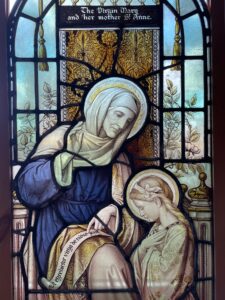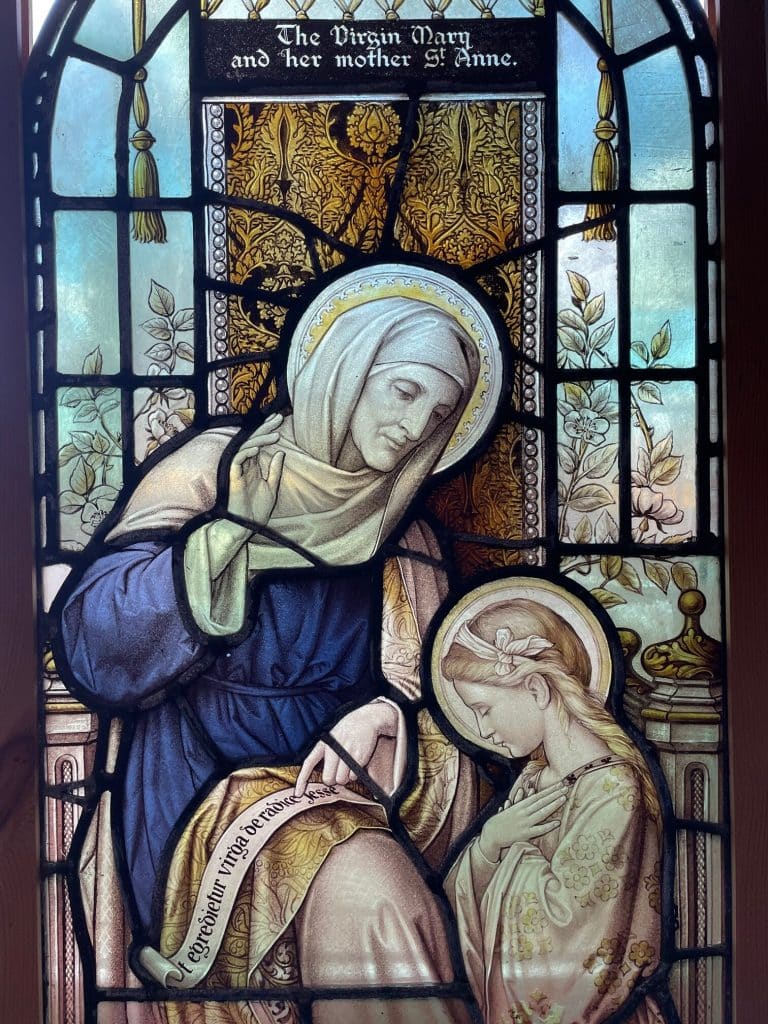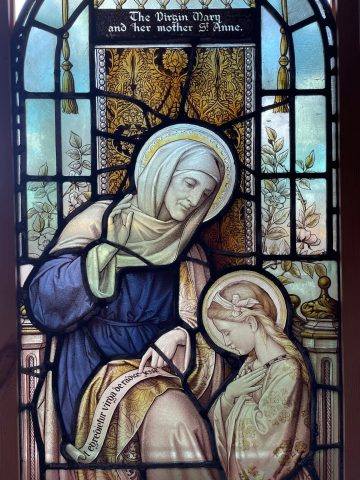
Last Sunday I listened to a gorgeous celebration and meditation on Advent, presented by Gina Colvin and Maxine Hanks. The rare conjunction of Saturn and Jupiter was mentioned, along with apocryphal accounts about the immaculate conception of Mary in the body of her mother, Anna, as well as the conception of the Christ child in the body of his mother, Mary. They spoke of the bringing together of contraries, and the powerful energy created in that kind of space. Just as the disparate and distant heavenly planets of Jupiter and Saturn appeared to connect and create a new light in the sky, these women from long ago created a divine presence of God on earth from their lowliest of positions in their society.
Anna was shunned by her temple and church leaders. She listened to the divine call to create life in a way that was unheard of, and not in line with the established way.
Mary also heard and accepted the divine call to create the life of God in the world. She did so outside of the law. She did so, fully aware that the cost could be her life, her existence. She had to trust, to have faith, that her part of creating something that was considered illegitimate in her world, could bring about a way of being, a life of love that would transcend human law, and reveal a higher divine law.
We discussed the role Mary’s mother must have had in all this. What had she shared, and taught Mary? Was she there for the birth of her grandchild? Did Mary go to her cousin Elizabeth right away, because she had learned from her mother to recognize the divine role women played in Godlike creation, even and especially when inspired messengers declared news that was outside the established law.
So much of this story is not something to be known, or answered, or proven.
The unanswerable, mystical nature of it spoke to me, and I relished this discussion. I find the core messages of the restored gospel to be very mystical. Not so much about provable, definite answers of certainty, but rather much more about a created, divine journey of seeking greater life.
During this Advent discussion, I kept thinking of my Mary and Anna stained-glass window.
24 years ago, I was in London helping my dad with his Theater Study Abroad student group. I spent one Saturday morning at the marketplace on Portabello Road. I noticed a few very old stained-glass windows outside one of the shops. I was captivated by one of them, which was unlike what I had seen in any of the many churches and cathedrals I had visited.
It depicted a woman, whose face resembled that of my great grandmother. The face of the young girl kneeling before her looked very much like the face of my eldest daughter.
I kept looking at each detail of this small, exquisite window. The woman was teaching the girl from a script. The girl was humbly listening.
Then I noticed the title near the top of the window.
The Virgin Mary and her mother, St. Anne.
This was Mary, being taught by her mother. She was learning of her heritage. I knew the scriptural accounts of the women in Mary’s ancestry were of women in the margins, women who did not fit into the acceptable or expected traditions or laws.
I went into the shop and asked about the window. It had been made in the 19th century, by a company that was known for the unusual colors of its windows. It was made for a church that was built in 1850. The church had recently been demolished. This shop housed the salvage company which had removed anything from the building that could be saved. I looked at other items in the shop – large, exquisitely carved altar pieces, and huge windows depicting scenes of scripture stories.
I expressed wonder that a church which held such a beautiful window would be torn down. The owner patiently explained that there were not always resources to save, maintain, or repair the old churches. He said that some were demolished without any attempt to salvage any part of them. He was grateful to be a part of saving pieces that could still be appreciated, even when the building was no longer of benefit.
I thought of how vehemently some, including myself, might cling to old traditions and structures that were no longer working to expand God’s kingdom, God’s love here on earth. At what point can I let go of something that I have grasped, sometimes just because it has been around for a long time? Can I look for what it is about tradition, paradigm, stories and histories that is worth salvaging and continuing, and then let go of what should no longer be maintained?
It is a complex and difficult place to be – acknowledging a past once cherished which cannot continue as is, and embracing what can and ought to be salvaged, examined again, and created anew.
It is a place of contraries.
I thought of how Christ came to fulfill, complete, and do away with the old law. From this tradition, he became the savior that brought the new and great commandment to love one another.
I was able to purchase the window. The owner listened to me tell him about my great-grandmother, and daughter. About my love of the Nativity story, and collection of handmade nativities that expressed the individual nature of the artists. I was moved when he gave me a small section of another window, the only part they could salvage. He said the large window was of the angels appearing to the shepherds and proclaiming the good news. The small section he gave me showed just a hand, and part of a banner that had the words “Earth, peace”. I am grateful for his generous gift.
Today, I look at this unusual scene on my Mary and Anna window. A mother, teaching her daughter where she comes from, and who she is. I can almost picture Anna laying her hands on Mary, and anointing her to be the creator of divine life. There is no human-made law, or tradition that can speak more clearly, or inspire more deeply than this kind of blessing.
Would this image have been as moving to me if it were not so unusual? I don’t know.
I would love images of inspired, prophetic, divinely creative women to be displayed and encouraged everywhere, and not just in the Relief Society room, or the sister’s locker room in the temple. I would love images such as this to be used to teach boys and girls and everyone on the gender spectrum about the universal qualities of creation, and about how we can each be a part of bringing the life of God into the world, each in our own, uniquely creative way.
I find value in structure and pattern and practice. Daily prayer, and reading, and pondering, and study has helped me learn to listen, and serve, and show up, even when it is not easy or convenient, even when I don’t feel like it, or don’t want to deal with seeing God in people I don’t agree with. The practice helps me challenge what is known, to have room for what is beyond my knowing. It teaches me to be open to the divine voice. The structure and the practice are an important part of my journey, but the journey is not for the practice itself. It is meant to carry me further, without end.
Anna, and Mary, and others whose lives were shaped by strong faith practices, were not led by an angel to follow tradition, or past practices, or wait for permission from church authority before accepting the call to create a new life for themselves and others. This might seem to be something assigned only to these women, but it is very much in line with what Christ did with his life, and the example he asked us to follow.
This is a message for all of us.
I look at this scene of Anna and Mary, I am reminded of the power, the need we have to share our moments of recognition. Those moments when we see something divine within us, within each other.
I look at the small window piece that is salvaged from wreckage that once depicted angels reaching out, proclaiming the good news… “And on Earth, Peace. Good will toward men.” There on this piece is the outstretched hand, and the words “Earth, peace.”
This is the message of the good news of the gospel that brings me hope at this time of the longest, darkest nights.
And I look forward to the coming light.




6 Responses
This is so beautiful, and soothing and reassuring to my troubled heart. Thank you.
I love this writing and the contemplation it brings me. Thank you for sharing this beautiful art and your journey finding it ❤
Ah, Jody, this is just what I needed to read today to get in the Christmas Spirit. Thank you!
beautiful
Thank you for this beautiful post. It inspires me to spend more time in contemplation. When I was in jersualem, my favorite spot was in st. Anne’s church. Like you, when I walked inside I was struck by the statue there of a young Mary sitting at her mothers feet and thought about what kind of woman she was to teach and raise the mother of the Savior.
A beautiful window! And I loved your beautiful thoughts about it!